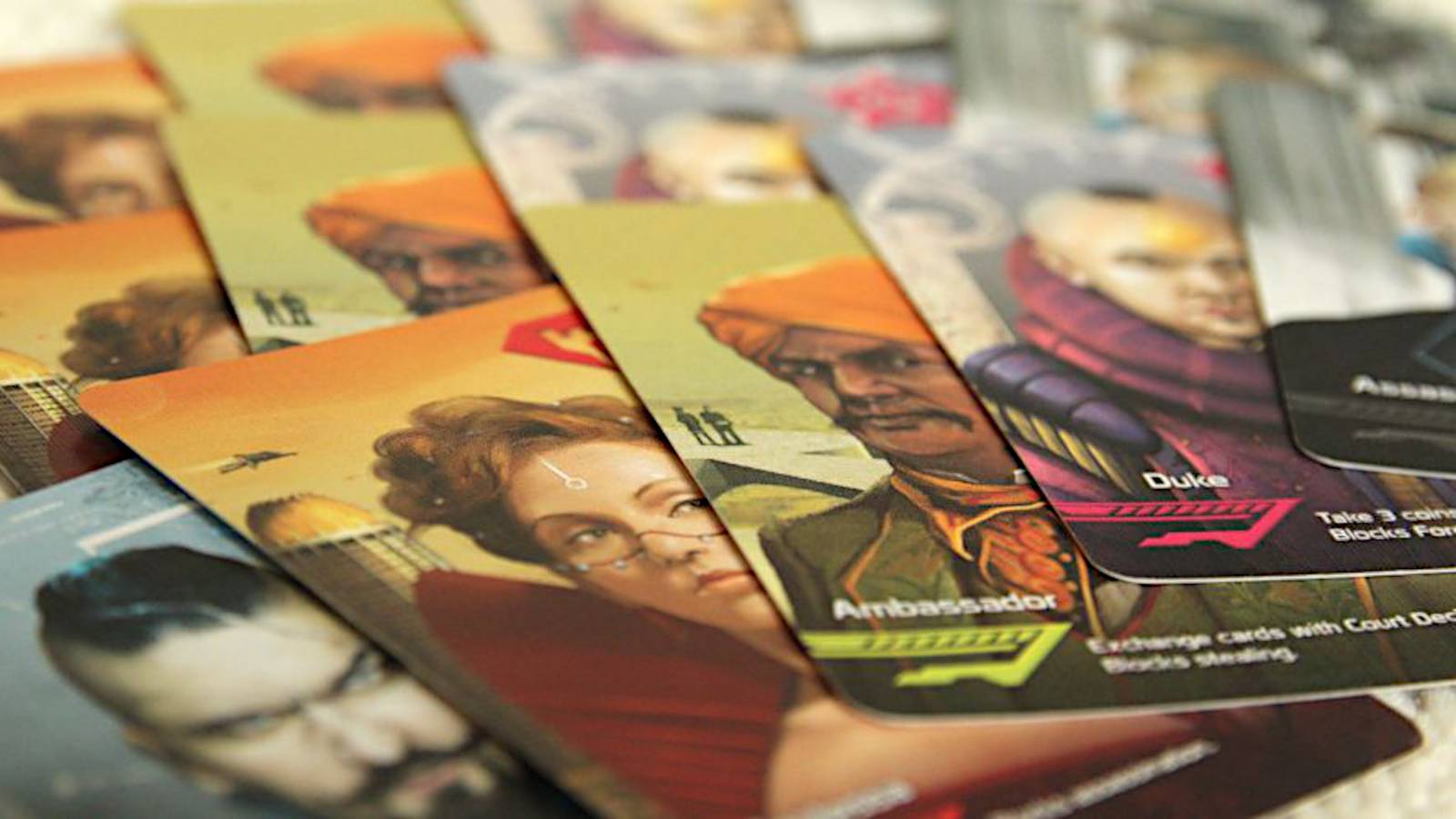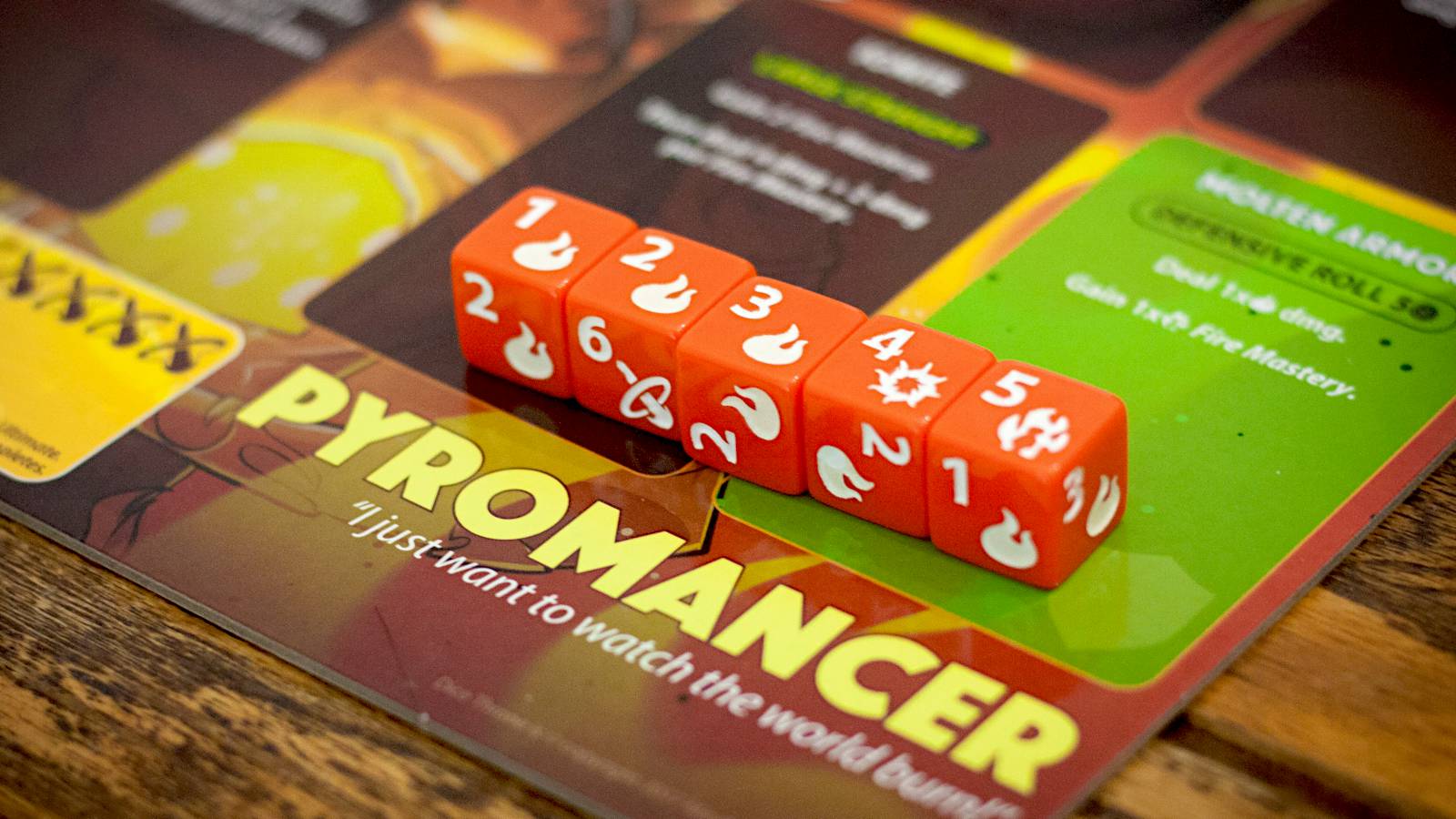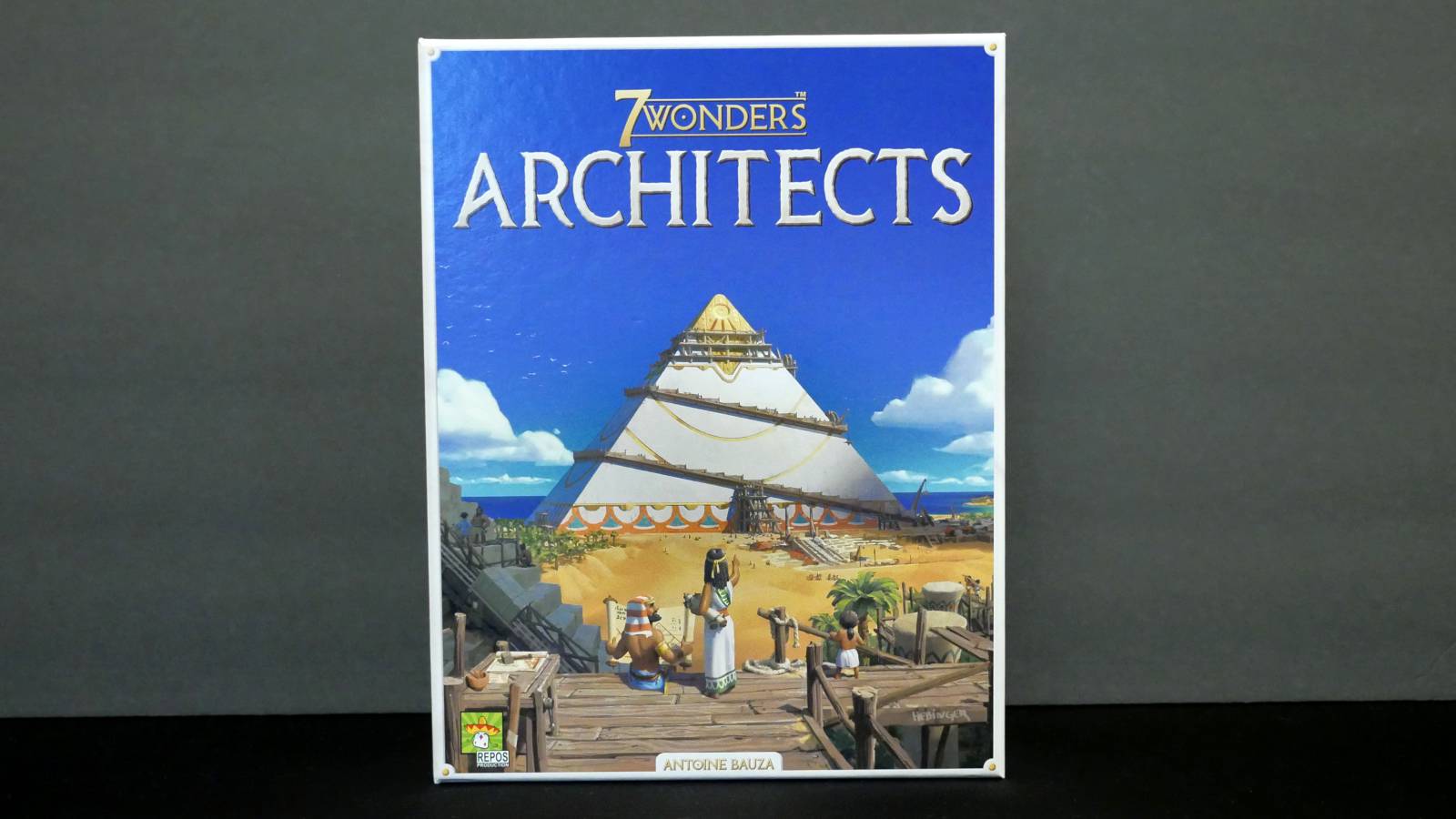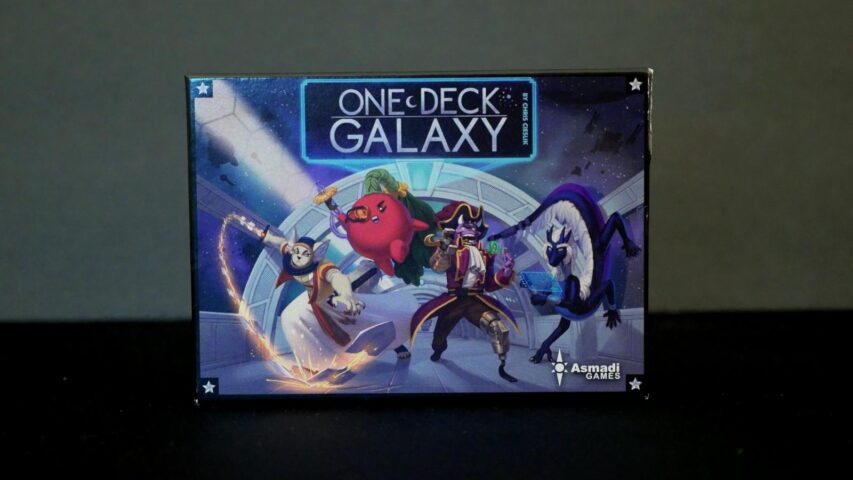Game: 7 Wonders: Architects
Release Year: 2021
Publisher: Repos Production
Designer: Antoine Bauza
Player Count: 2 to 7 players
Play Time: About 7 minutes per player
Rules Complexity: Simple
No one can deny the impact that the 7 Wonders franchise has had on modern board gaming. When the original 7 Wonders came out in 2010, it popularized card drafting and redefined the possibilities of what a card game could be.
Then, in 2015, 7 Wonders Duel came out and shot up to become one of the most popular two-player board games of all time.
Most recently, we got 7 Wonders: Architects, which isn't an expansion to 7 Wonders but rather an entirely separate game that takes some of the core ideas and spins them off into a streamlined package. Without a doubt, 7 Wonders: Architects is the simplest of all the 7 Wonders games.
But is it any good? Does it have lasting power beneath its stunning production? How well does it stand out against all the other games that could stand in its place? Here's everything you need to know about 7 Wonders: Architects and whether this is a game worthy of a spot in your own board game collection.
This review is based on my own personal copy of 7 Wonders: Architects, which I bought on sale from Detective Hawk Games. Not a free review copy.
Overview
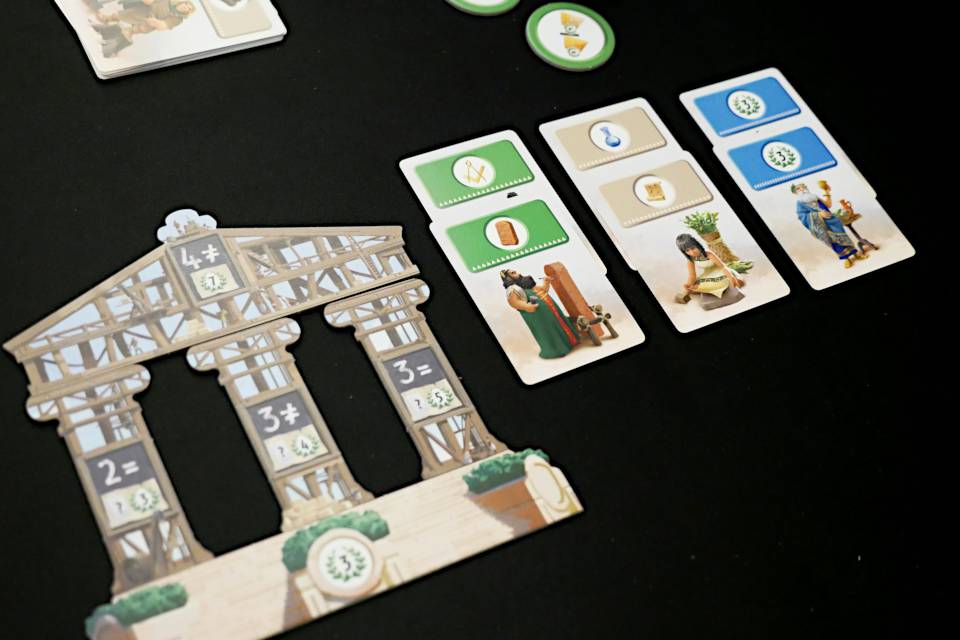
In 7 Wonders: Architects, you play as one of seven ancient civilizations racing to complete your Wonder of the Ancient World before anyone else. Once someone finishes their Wonder, the end of the game is triggered—but the winner is whoever earns the most points during the game, not necessarily the one who finished first.
At its core, 7 Wonders: Architects is really just a card game. Each civilization comes with its own unique deck of cards, which is placed face-up between yourself and the player to your right. In other words, each player has access to two decks: their own deck as well as the deck of the player to their left.
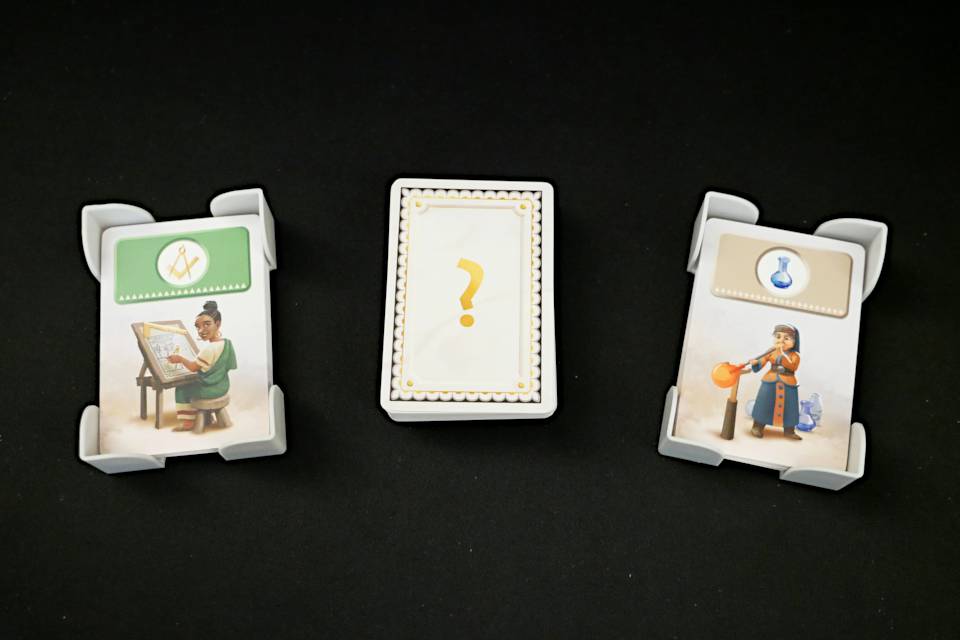
You don't have a hand of cards; instead, you draw a card from one of the two decks available to you, then play that card right away. If you don't like either card available to you, you can also draw from the central common deck—but this common deck is face-down, meaning you're playing the odds.
7 Wonders: Architects is a set collection game. The cards come in different types, with each type offering its own benefits when you collect a proper set:
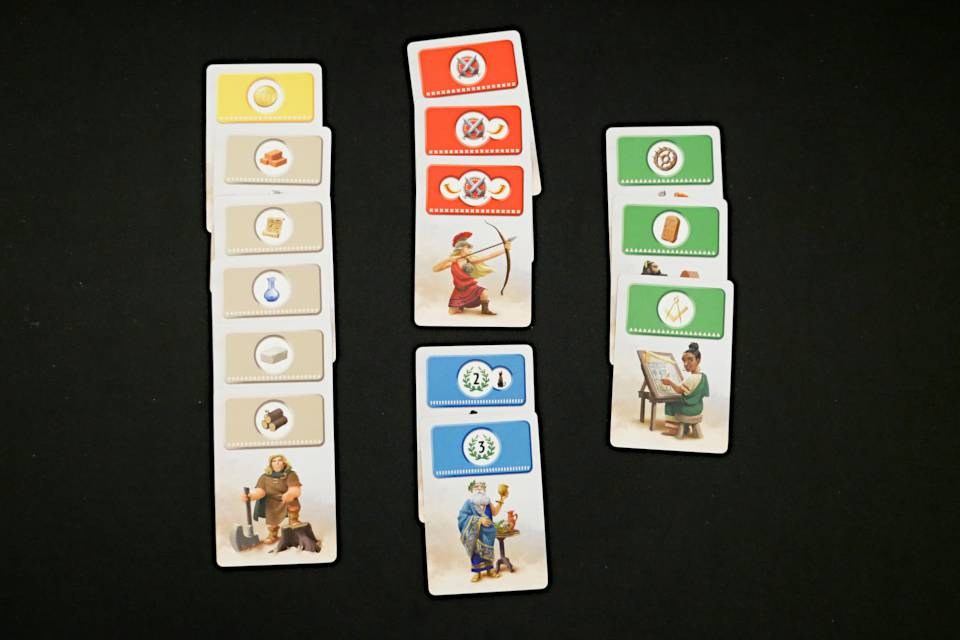
- Resource cards are used to build the pieces of your Wonder. By collecting sets of the same resource or sets of all different resources, you can make progress on your Wonder, which earns you points and special actions.
- Science cards are used to acquire permanent bonuses, which can do things like allow you to draw extra cards on your turn when you do certain actions, earn points for achieving certain goals, etc.
- Military cards come into play when a War is triggered. To resolve a War, you compare your Military against both of your neighbors—in each case, if you have more Military, you earn points for "winning the battle."
- Point cards are just that: flat points. These offer fewer points than the other card types, but these points are guaranteed. Plus, some of the Point cards allow you to take possession of the Cat. (Whoever has the Cat can peek at the top card of the common deck before deciding which deck to draw from.)
So, turn by turn, you simply draw a card and play it in front of yourself. If you make a set, you turn it in for whatever benefit it bestows. Once someone completes their Wonder, the game ends and points are tallied to determine the winner.
Setup and Table Footprint
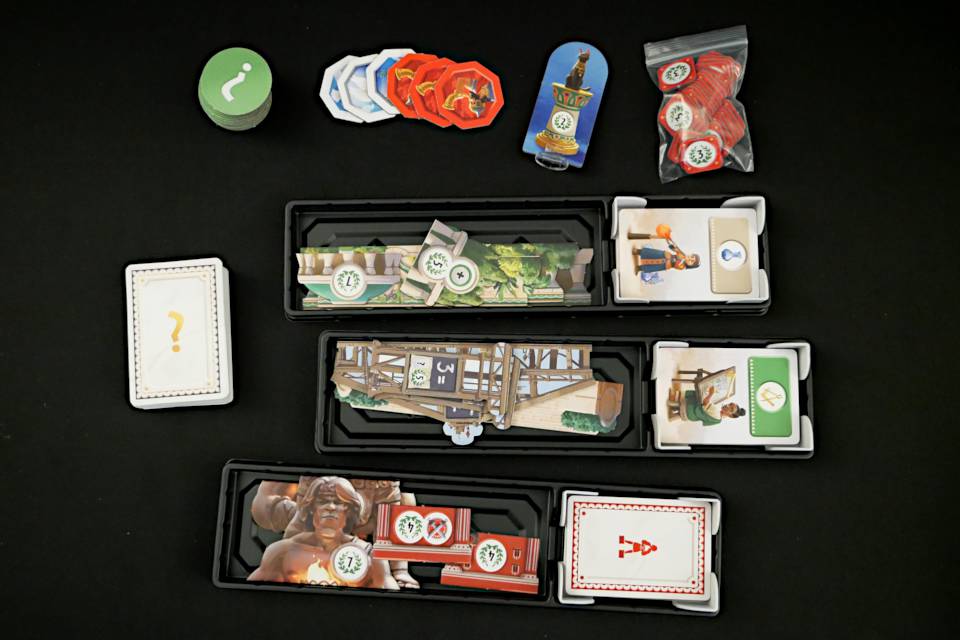
Perhaps the greatest aspect of 7 Wonders: Architects is its setup. Each civilization comes with its own container tray, which holds its cards and Wonder pieces. So, to set up, you simply pick a tray that has everything you need. It's really easy, quite fast, and surprisingly impressive.
Beyond that, there isn't much else to the setup. Fortunately, there's another container tray that holds all of the common pieces used during the game:
- Place the common deck in the center.
- Place the Science tokens and flip three to start.
- Place the War tokens to their Peace sides to start.
- Place the Cat in the center. No one possesses it yet.
All in all, you can be up and ready to play in just 2 to 3 minutes.
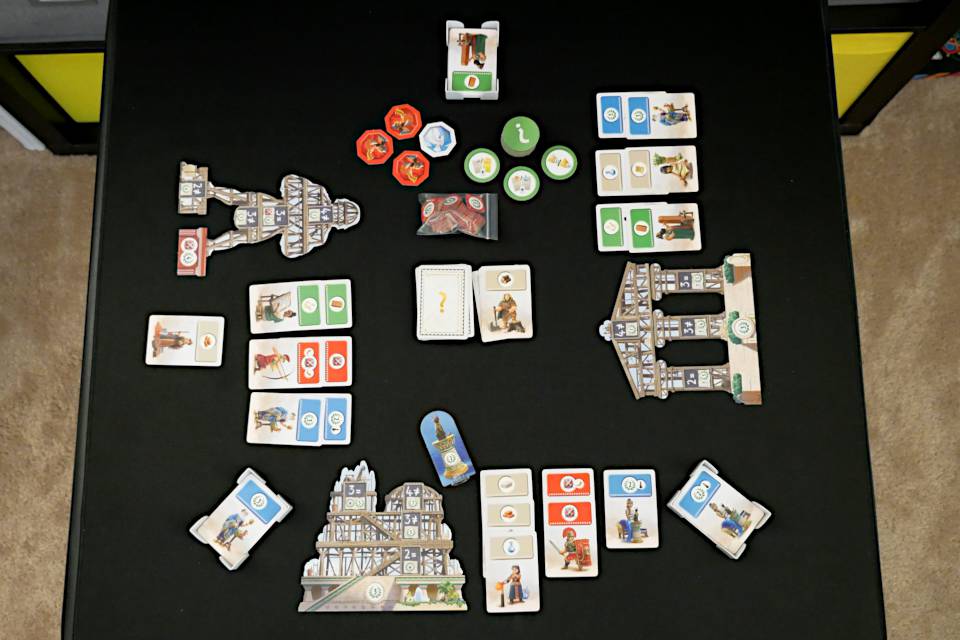
And despite how grand the production feels, 7 Wonders: Architects doesn't actually need that much table space. Sure, it's bigger than you might expect from what's essentially "just a card game," but it's still reasonable.
Each player needs enough room on the table for their tableau of card sets, but the tableaus never get too big because sets are constantly being turned in. The tableau also needs enough space for the Wonder pieces, of course.
All in all, the more players, the more space required. You can play on a small card table if it's just 2 to 4 of you. But if you're playing with 7 players and all of the civilizations? Well, you'll probably need a dinner table or similar.
Learning Curve
7 Wonders: Architects has a few things going on, but each piece is relatively simple. It is, after all, just a set collection game at heart—and it's clearly the simplest when compared to 7 Wonders or 7 Wonders Duel.
If you're playing with people who are familiar with games like Catan or Ticket to Ride, they'll be able to pick this one up with ease. Similarly, kids with past board gaming experience will be able to grasp this one quite quickly.
But if you're playing with people who have no gaming experience at all, I'd say 7 Wonders: Architects is a tad too much. Juggling Science, Military, and Resource cards can be complex for someone who has never set collected before.
Game Experience
Decision Space
7 Wonders: Architects is a lightweight game, and that really comes through in its minimal decision space.
On any given turn, you have two core choices: play the card on the deck to your left, or play the card on the deck to your right. These cards are face-up, so you're making an informed choice that plays into your strategy. Don't like either choice? You can always play the common deck and hope it draws to your favor instead.
But that isn't the only choice you're making. In fact, 7 Wonders: Architects is really the culmination of lots of micro-choices. The card draw is only one such micro-choice.

When you've collected a set of Science cards, you have a different micro-choice to make: are you going to take one of the three face-up Science abilities, or are you going to draw from the face-down stack and hope for better?
Or maybe you're playing as Rhodes—which offers extra Military strength as you complete Wonder pieces—so your strategy will be to trigger Wars as often as possible, hoping to amass points that way.
Or maybe you see that your neighbor will be able to complete their next Wonder piece with the top card of their deck, so you opt to draw that card simply to deny them that opportunity.
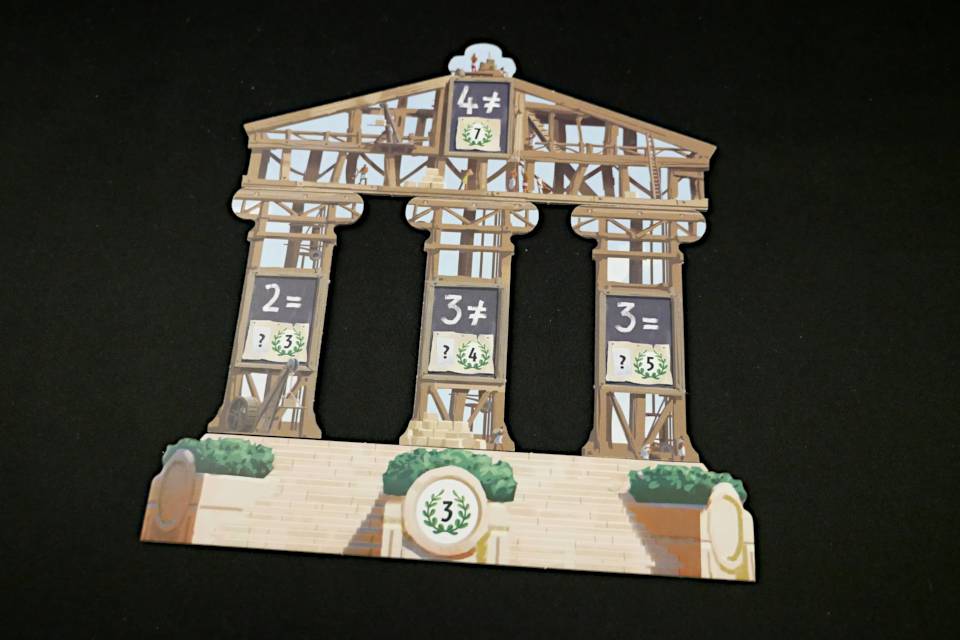
And speaking of Wonder pieces, sometimes you have a choice between which piece to construct next—and one of those pieces might grant a one-time bonus action. Are you going to build that piece next? Or are you going to defer it for later?
Don't get me wrong: 7 Wonders: Architects isn't a brainy game with lots of thinking involved. These micro-choices are as micro as they come. It's up to you to assess your situation on any given turn and make the right choices that will add up to victory.
Luck Factor
7 Wonders: Architects isn't a luck-based game, but luck does play a big role in dictating what you can do. That's always going to be the case when the central gameplay revolves around drawing cards from decks.
In this case, the luck of the draw will determine which cards you can choose between, and it's especially felt when drawing from the face-down common deck.
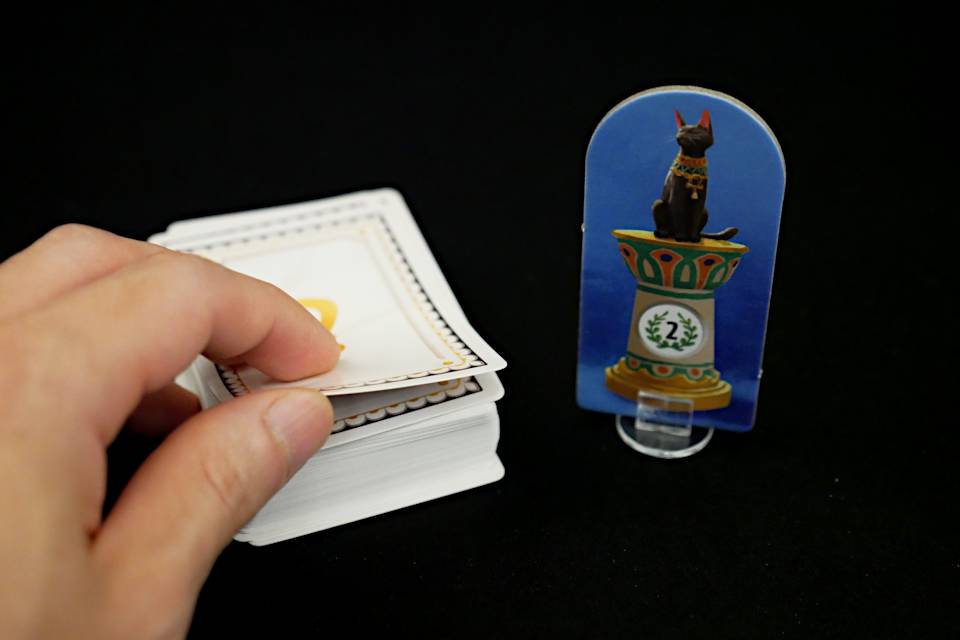
While the face-down common deck has a slight bit of luck mitigation in the form of the Cat (which allows you to peek at the top card before drawing), there's very little else when it comes to mitigating luck. At best, you can acquire Science abilities that let you draw extra cards for drawing certain types of cards.
Fun Factor
I wouldn't say that 7 Wonders: Architects is thrilling or exciting. It's a relatively relaxed game that plays smoothly and doesn't outstay its welcome. There isn't much in the way of conflict or tension, and there aren't many highs or lows.
It's... pleasant. It can even be satisfying at times. Seeing the progress of your Wonder is enough to keep you engaged from turn to turn, and you might even feel like you're making meaningful decisions along the way.
But 7 Wonders: Architects is like a Hershey's Kiss. It's far from nasty or disgusting, and it might even taste good as it melts in your mouth—but it's over in a flash and you're left wanting more. It's not bad, but there just isn't much to it.
Pacing
7 Wonders: Architects is surprisingly short. Given its lavish production, I was expecting a chunkier sort of game with more of a bite to it. Instead, I got a game that plays in as little as 10 minutes (with 2 players), which was jarring the first time.
And yet, despite how quick it is, 7 Wonders: Architects has a good sense of progression to it. You're constantly making sets and turning them in, which provides ample amounts of forward momentum, punctuated by the construction of Wonder pieces and the occasional Wars.
Almost everything grants points, and the things that don't still grant opportunities to earn more points later on down the line. It's constantly building all around you and you're hoping that you're amassing points faster than everyone else.
And the finish line is always in sight: as soon as someone finishes constructing their last Wonder piece, the game ends. It's about as engaging as a 100-meter dash.
Player Interaction
There's almost zero player interaction in 7 Wonders: Architects.
Apart from drafting a card that your neighbor wants, or acquiring a Science ability that somebody wants, or taking the Cat from someone, there's no other way to interact with people. There's no trading and no attacking. Even the Wars are little more than comparing what you have with someone else.
As such, there's no significant difference between playing with 2 players or 7 players. You're only concerned with the two players sitting on either side of you, and even then there's nothing you can really do to them.
Replayability
When it comes to replayability, 7 Wonders: Architects baffles me.
If I pull back and think about the game as a game, it's pretty fun. I've played many times by now and it's engaging every time. I've yet to find myself bored while playing it, and I've never regretted playing it.
But when I'm not playing it? I don't feel drawn to it. And I think it has to do with the mismatch between the simplistic gameplay and the exaggerated production.
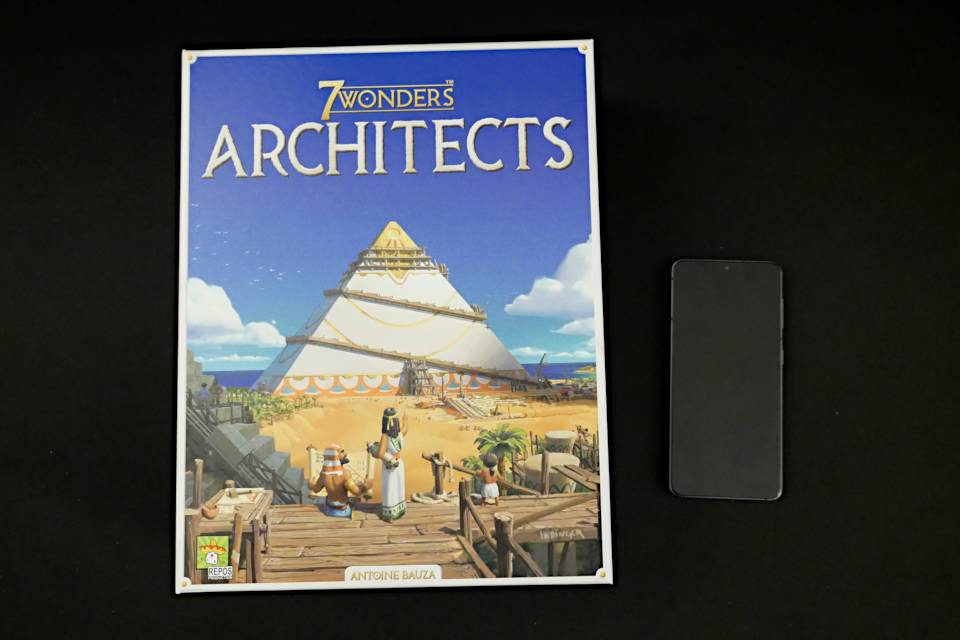
The thing is, if 7 Wonders: Architects was a small-box game that was 90% to 95% cards and maybe some tokens for tracking points, then I'd be all over it. It'd fill the same niche as games like Jaipur, Scout, For Sale, and PUSH. Boil it down and you get a small-box experience: draw one, play one, collect sets.
And yet, the box for 7 Wonders: Architects is sizable. It's bigger than most medium-box games, which just makes it a chore to table—and that's true even with the container trays that keep everything organized. In other words, it's the fact that container trays are even necessary that makes it cumbersome.
So, for that reason, I don't come back to this one.

It doesn't bother me that 7 Wonders: Architects has seven different civilizations that aren't very different from each other at all, or that the gameplay is simple and "the same" from game to game, or that there isn't much strategy, or that there aren't many highs or lows while playing it. I think it's enjoyable despite all that.
But 7 Wonders: Architects commits the unfortunate blunder of being an over-produced game, one whose box is ten times larger than the game inside. If I want to play a small game, I'll pull out a small game; if I want a big game, I'll pull out a big game. 7 Wonders: Architects just isn't the overall package that I want.
Production Quality
I have to repeat this: the production quality for 7 Wonders: Architects is downright impressive. Everything is smartly packed together in a way that eases setup, eases cleanup, and makes it a game that's easy to table.
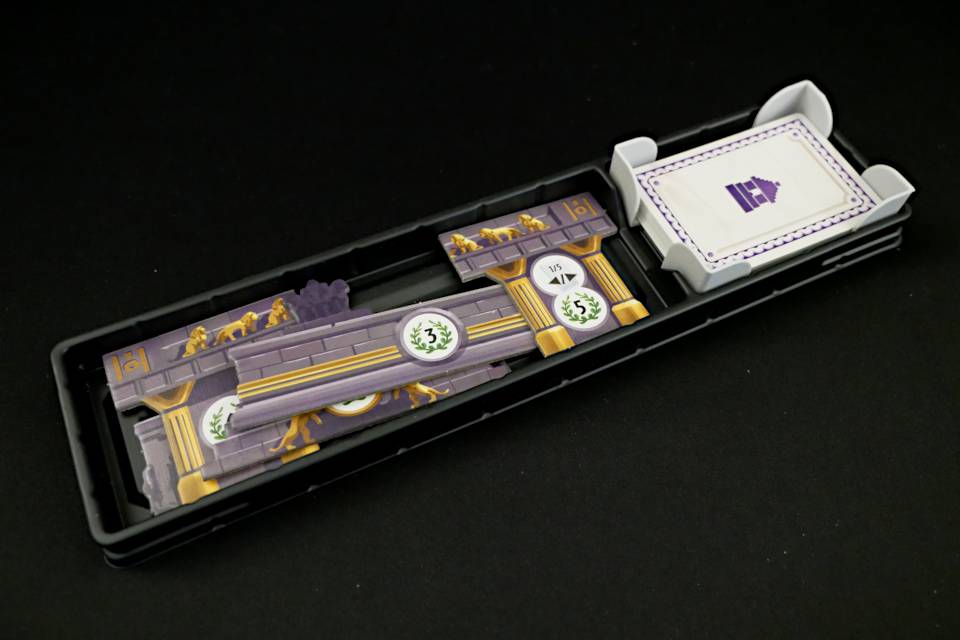
The container trays are phenomenal. I normally find container trays to be superfluous, but the trays in 7 Wonders: Architects are pretty good. (The only other game with container trays that I've liked? Dice Throne. These are on par with those.)
As I mentioned in the "Replayability" section above, I'd rather that this game was refined so that it didn't need container trays at all, but if it's going to need container trays, these are top-notch ones that don't disappoint.
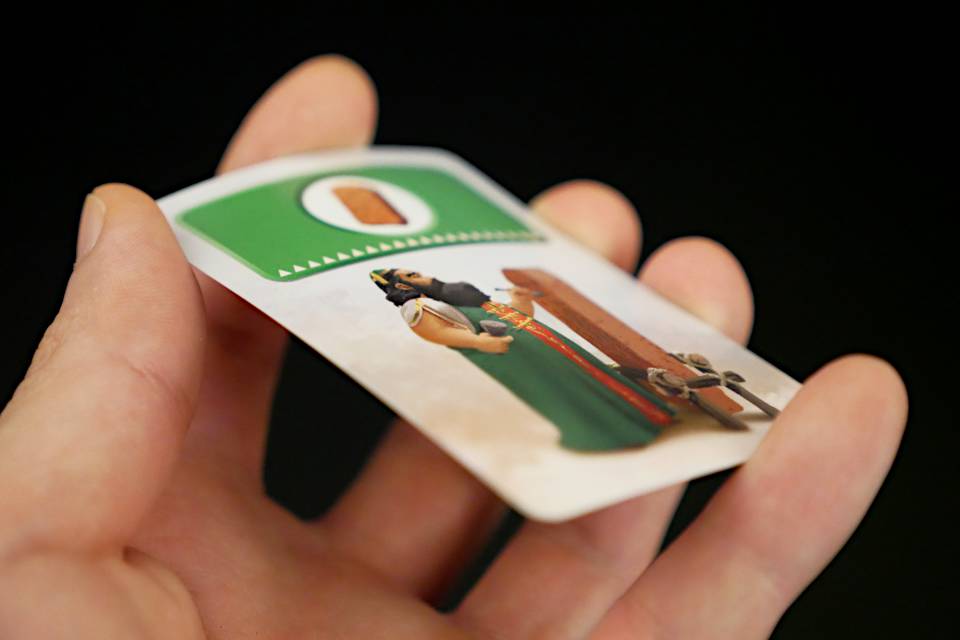
The cards are good quality with clean graphic design. The cards in 7 Wonders: Architects don't feel cheap, which is important for what's essentially a glammed-up card game. The graphic design is straightforward, colorblind friendly, and augments the streamlined appeal of the gameplay.
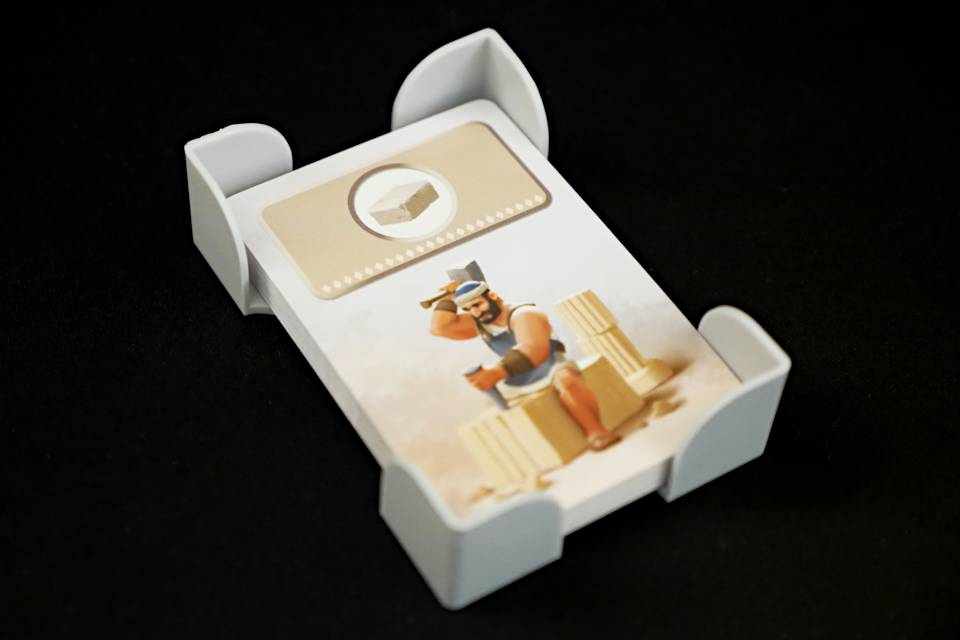
The card holders subtly elevate the experience. It's not just that each civilization comes with a container tray—they also come with their own card holders. These card holders aren't just organizational, but they allow the civilization card decks to be displayed face-up while preventing accidental peeks at cards beneath. Honestly, the game would be a messy experience without these.
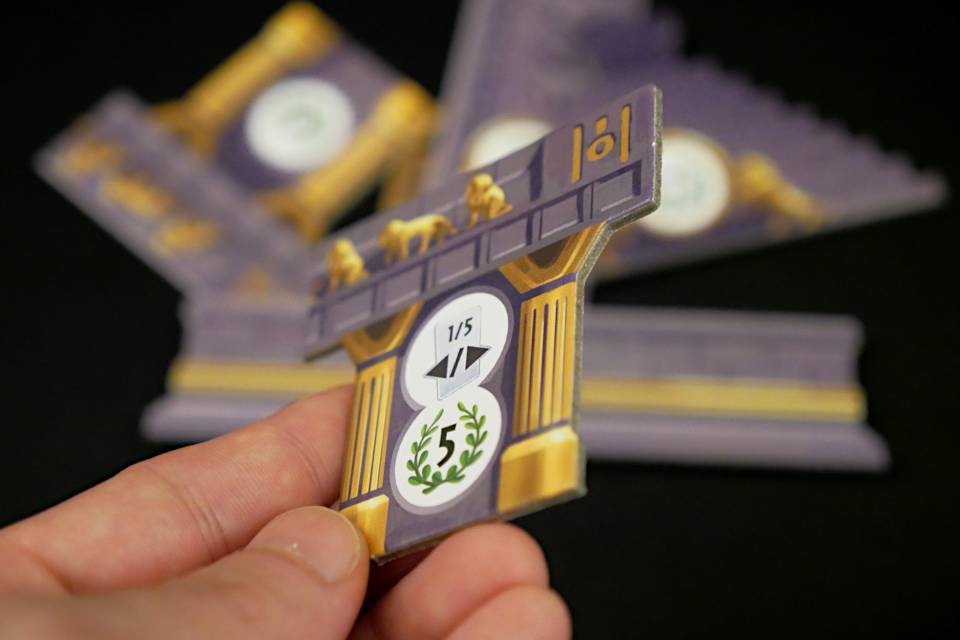
The cardboard Wonder pieces are satisfying. With the Wonder pieces, 7 Wonders: Architects captures what it feels like to build towards the completion of a monument. As each piece is completed, you flip it over—and that piece goes from being an empty frame to a beautiful chunk of artwork. It's lovely.
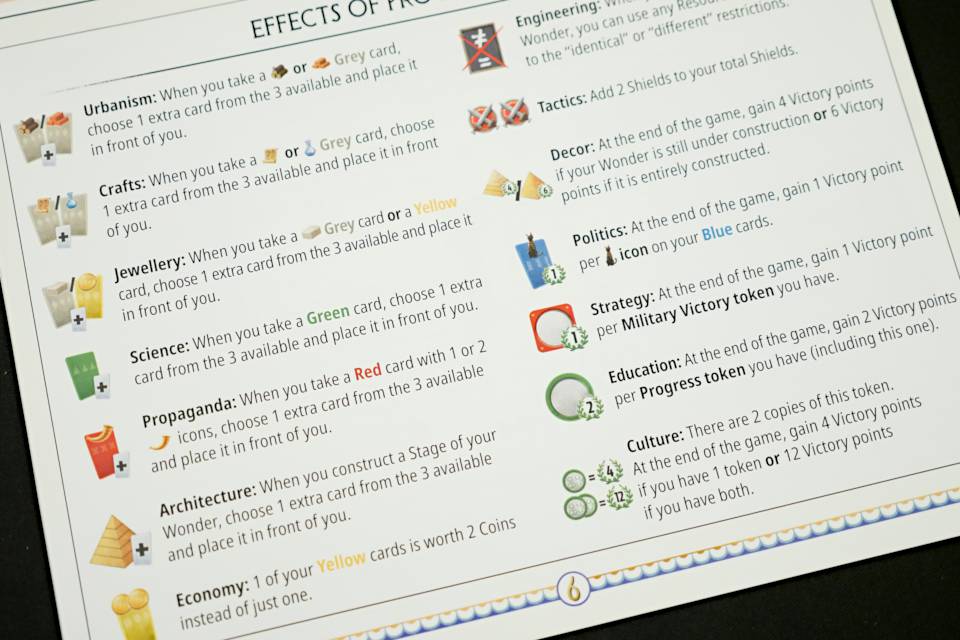
The Science iconography can be confusing, but there's a player aid. The icons that represent each civilization's special power as well as the various Science abilities? Well, they can be confusing, but they aren't problematic because the back of the rulebook explains every icon. A nice touch that I appreciate.
The Bottom Line
7 Wonders: Architects
- Simple and satisfying set collection gameplay
- Fantastic production with built-in container trays for organization
- Appealing design and approachable theme
- Gameplay is much smaller than the box
- Too much setup for its bite-size experience
- Fun in the moment but not compelling enough for long-term replayability
Buy this game • Amazon • Game Nerdz • Noble Knight Games. If you buy using these links, I may earn a commission at no extra cost to you. It's one way to support me and this site. Thanks!






